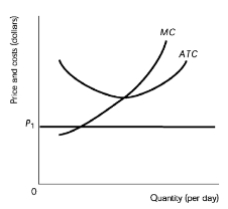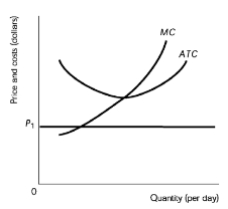Alright, so we've seen how the long-run market supply stabilizes at the minimum average total cost (ATC) price, right? So I want to show you how even if there's a change in demand, whether an increase or decrease, it will still stabilize at that minimum ATC. Alright, let's go ahead and walk through an example and show how we're always going to end up in the long-run situation that we've seen. Let's check it out. So we're going to see that shifts in the demand curve are going to create a short-run profit or a loss and that's going to cause firms to enter and exit, and then we're going to end up back at the same equilibrium. Okay? So remember, in the short run, firms can earn economic profit, right? But in the long run, firms earn no economic profit. We've discussed that already, so let’s start in our long-run equilibrium. Let’s say we’ve reached our equilibrium and this is going to be our starting point. On the left, I have graphs of the whole market and on the right, we're going to have graphs for an individual firm.
So, let's start here in our long-run equilibrium, and we've got some sort of supply and demand that gets us to our equilibrium price right here and our equilibrium quantity. Something like this. That P1 is our equilibrium price that we found in the long run. And this black line, just like we discussed in the previous video, we had that flat long-run supply curve at the price, at that minimum ATC price, and that's what we see on the right-hand graph. If you look at the right-hand graph for the individual firm, at that price we've got our minimum ATC. We're going to be producing right here where marginal cost crosses the marginal revenue curve. The cost crosses the marginal revenue curve. The price is equal to average revenue and equal to marginal revenue in perfect competition. At that price, we're going to produce this quantity and earn 0 economic profit because price equals ATC at that point, so there is no profit. This isn't really Q Star; this is just the quantity that that firm is going to produce.
Now let's say there’s some sort of change that increases demand. Say, if this is wheat we're talking about, maybe everyone finds out that gluten-free diets are a hoax and gluten is the best thing for you ever, and everyone wants gluten now. There’s some sort of change in the market that causes an increase in demand. So now when we increase demand, we shift the demand curve to the right. We had our original equilibrium right here, where we were at this price P1, and now demand has shifted to the right. In the short run, what do we see? We found a new equilibrium up here. This is our new equilibrium, where the new demand curve touches the supply curve. So, we're going to have this new quantity, a higher quantity from our previous equilibrium, and a higher price, P2 up here, some higher price because of this increase in demand.
So, what’s going to happen to the individual firm now that there’s this higher price? The market is at P2, and P2 is now our price, which is our average revenue, which is also our marginal revenue. That marginal revenue is touching our marginal cost curve right here, and that's where we're going to produce. Notice that our marginal cost curve and our average total cost curve haven’t changed from the graph above; it's the same graph. All that's changed is this higher price because of the increased demand, and what do we see happening now? Now, the price is greater than the average total cost. This little area right here, that's going to be our profit. So now, in the short run, firms are making a profit. And what did we say? When firms are making a profit in the short run, what’s going to happen? Other people are going to get into the market. Firms are going to enter the market because there are short-run profits. So let’s go down to this last graph and let’s see what happens when these firms start entering the market.
Notice we had our increased demand, right? And our original supply right there. This was where we were, and people were making a profit, right? At this higher-priced P2, the firms were making a profit and other people are like, "Hey, there's money to be made, let’s get into the market." So more firms start entering the market and it increases the supply. The supply is going to start increasing now, and what's going to happen is firms are just going to keep entering and keep entering until the profits are eliminated. You can imagine this doesn't all happen in one fell swoop; it's not like we move from S1 to S2 just in one quick moment, but what's happening is firms are just going to keep entering and keep entering, right? We're going to have all these supply shifts to the right as firms keep entering the market until we find this equilibrium again and guess what happens? Here at this equilibrium, now we're over here where the new demand curve touches the new supply curve, and we're back to P1. Now we're back to P1 and all that’s happened is we're supplying more quantity, right? Because there was some increased demand and more firms entered the market to satisfy that demand. And now we're back to our original situation for the firms: the firms are back over here at P1 at their minimum ATC, producing that same quantity they were producing originally, right? There are just more firms in the market supplying to fulfill that bigger demand. So there we go, we always end up back at this equilibrium where price equals minimum average total cost, the minimum ATC. That is going to be our long-run equilibrium, and you just saw how even changes in demand can lead us back to this same situation. Cool? Alright, let's go ahead and move on to the next video.



